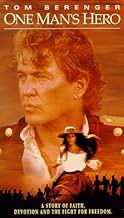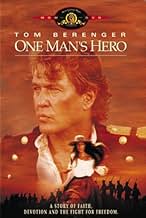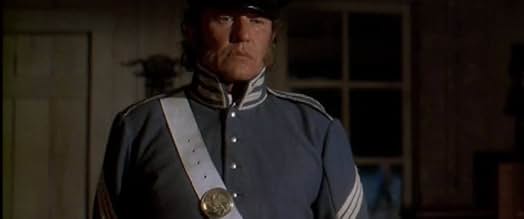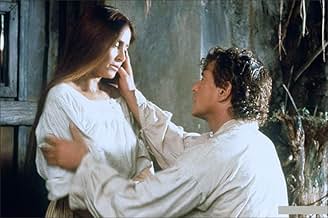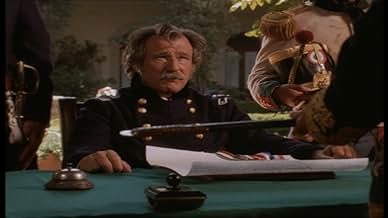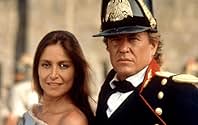VALUTAZIONE IMDb
6,0/10
1408
LA TUA VALUTAZIONE
Aggiungi una trama nella tua linguaJohn Riley, an Irish immigrant soldier recruited in the American army during the Mexican-American War faces anti-immigrant and anti-Catholic bigotry from his fellow servicemen and defects to... Leggi tuttoJohn Riley, an Irish immigrant soldier recruited in the American army during the Mexican-American War faces anti-immigrant and anti-Catholic bigotry from his fellow servicemen and defects to the Mexican army.John Riley, an Irish immigrant soldier recruited in the American army during the Mexican-American War faces anti-immigrant and anti-Catholic bigotry from his fellow servicemen and defects to the Mexican army.
- Regia
- Sceneggiatura
- Star
- Premi
- 3 candidature totali
Recensioni in evidenza
When it comes films based on true events, it is in the filmmakers' best interest to keep all the facts as legitimate as possible without skewing the story all that much. The genre of films that probably receives the most critical of film buffs' attentions are the ones that have been historically recorded and not some fable spread by rumors and myths. Taking a deeper look, the type of historical film that gets this kind of focus is usually bio-pictures or war dramas. Further closing the gap, the war dramas that have received the motion picture treatment range; but several have depicted these tragedies during the Great War, World War II, the Vietnam War, the Revolutionary War and the American Civil War. Of course in world history, these are not the only confrontations that occurred, but for North American history, this is the usual batch. It is rare when another event is looked at that possibly was forgotten in the regular high school history books. The most recent that comes to mind is Heaven's Gate (1980), which was about a county war in 1890.
Turns out this movie takes place during the 19th century as well. Lance Hool, a producer to other various films like Missing in Action (1984), The Air Up There (1994), Flipper (1996) and Man on Fire (2004), takes a turn in the director's chair to cover the Mexican-American War in 1846. Written by Milton S. Gelman (who passed practically a decade before this film's release), the story is about real-life soldier Sergeant John Riley (Tom Berenger) and his men who abandoned the U.S. army after being persecuted because of their Catholic faith. While leaving, they find refuge with fellow Mexicans led by Cortina (Joaquim de Almeida) and Marta (Daniela Romo). There, they both decide to join Mexico and fight for their freedom. Meanwhile, Colonel Benton Lacy (Mark Moses) attempts to get Riley back to the north before General Winfield Scott (Patrick Bergin) blows them all away. Running parallel to that, Marta and Riley start to become more attracted to each other every minute they spend together.
For problems, there isn't all too much to gripe about. The only script issues that are obvious deal with character motivations. From what is known, John Riley is somewhat a mystery but only after the Mexican- American war ended. There are documents of his existence but there isn't a clear answer as to what he did post-war. Did he marry for real? In this feature, Marta is Riley's love interest as is she to Cortina. The passion that Riley has for Marta is a constant subplot that is brought up every half-hour or so. Yet Cortina repetitively reminds Riley to stay away, but Riley doesn't listen. Soon, Riley and Cortina fight and immediately right after; it's water under the bridge for some odd reason. What was all the antagonizing for if it was going to be settled so quickly? Was it even worth writing in? The only other dilemma in this movie is more technical and that's the depiction of war. This film was Orion Pictures last release and many of the studio's films were rated R (as was this one). Still there seems to be almost no blood or gore.
That particular aspect was probably the most inaccurate component. War is not light and fluffy stuff. There are a couple scenes where blood does flow but it's rated R. Gettysburg (1993) also should have been R but it was PG so the depiction of violence was much less gruesome and that's only appropriate because of its rating. Why give a movie the label of rated R if won't even play out as an R rated film? It's misleading. The cast to the film was also entertaining. Hearing Tom Berenger with an Irish accent is definitely a change in his usual speech pattern and it does sound authentic, as well as the soldiers played by Stuart Graham, Gregg Fitzgerald, Don Wycherley, Wolf Muser and Luke Hayden. Each actor equally matches Berenger in amiability. Daniela Romo as Marta is very pretty and it is obvious as to why Riley falls for her so quickly. Joaquim de Almeida is always fun to watch but in his role as Cortina, it's hard to know how trustworthy he is. Mark Moses performance as Colonel Lacy is another great show. Moses knows how to have a presence.
Visually, the film had an appealing look to it. All effects looked like they were executed practically, of which regularly gives a movie a more realistic viewing. Credit to João Fernandes as the director of photography for capturing wide shots of the western North American terrain. The actual depiction may not feel it has the right temperature to walk in casual clothing but it rightfully matches the environment of what the west was like. Fernandes was also the cinematographer for Friday the 13th Part IV: The Final Chapter (1984), Missing in Action (1984) and Red Scorpion (1988). The film score produced by Ernest Troost was another great element. Troost also composed the music to both horror comedies Tremors (1990) and Dead Heat (1988). Unlike Dead Heat (1988) though where the orchestra sounded like it came from an oldies monster film, Troost's orchestra to this film is much more full and contemporary. The main title is very applicable to the setting, with bagpipes representing Riley and his men. There's also a choir to boot.
It has some weird character motivations and underwhelming violence for an R rated war film, however it is an immersive film. The story provides a new history lesson to those unfamiliar of the Mexican-American war, the actors perform great, and the cinematography is befitting to the setting as well as the film score.
Turns out this movie takes place during the 19th century as well. Lance Hool, a producer to other various films like Missing in Action (1984), The Air Up There (1994), Flipper (1996) and Man on Fire (2004), takes a turn in the director's chair to cover the Mexican-American War in 1846. Written by Milton S. Gelman (who passed practically a decade before this film's release), the story is about real-life soldier Sergeant John Riley (Tom Berenger) and his men who abandoned the U.S. army after being persecuted because of their Catholic faith. While leaving, they find refuge with fellow Mexicans led by Cortina (Joaquim de Almeida) and Marta (Daniela Romo). There, they both decide to join Mexico and fight for their freedom. Meanwhile, Colonel Benton Lacy (Mark Moses) attempts to get Riley back to the north before General Winfield Scott (Patrick Bergin) blows them all away. Running parallel to that, Marta and Riley start to become more attracted to each other every minute they spend together.
For problems, there isn't all too much to gripe about. The only script issues that are obvious deal with character motivations. From what is known, John Riley is somewhat a mystery but only after the Mexican- American war ended. There are documents of his existence but there isn't a clear answer as to what he did post-war. Did he marry for real? In this feature, Marta is Riley's love interest as is she to Cortina. The passion that Riley has for Marta is a constant subplot that is brought up every half-hour or so. Yet Cortina repetitively reminds Riley to stay away, but Riley doesn't listen. Soon, Riley and Cortina fight and immediately right after; it's water under the bridge for some odd reason. What was all the antagonizing for if it was going to be settled so quickly? Was it even worth writing in? The only other dilemma in this movie is more technical and that's the depiction of war. This film was Orion Pictures last release and many of the studio's films were rated R (as was this one). Still there seems to be almost no blood or gore.
That particular aspect was probably the most inaccurate component. War is not light and fluffy stuff. There are a couple scenes where blood does flow but it's rated R. Gettysburg (1993) also should have been R but it was PG so the depiction of violence was much less gruesome and that's only appropriate because of its rating. Why give a movie the label of rated R if won't even play out as an R rated film? It's misleading. The cast to the film was also entertaining. Hearing Tom Berenger with an Irish accent is definitely a change in his usual speech pattern and it does sound authentic, as well as the soldiers played by Stuart Graham, Gregg Fitzgerald, Don Wycherley, Wolf Muser and Luke Hayden. Each actor equally matches Berenger in amiability. Daniela Romo as Marta is very pretty and it is obvious as to why Riley falls for her so quickly. Joaquim de Almeida is always fun to watch but in his role as Cortina, it's hard to know how trustworthy he is. Mark Moses performance as Colonel Lacy is another great show. Moses knows how to have a presence.
Visually, the film had an appealing look to it. All effects looked like they were executed practically, of which regularly gives a movie a more realistic viewing. Credit to João Fernandes as the director of photography for capturing wide shots of the western North American terrain. The actual depiction may not feel it has the right temperature to walk in casual clothing but it rightfully matches the environment of what the west was like. Fernandes was also the cinematographer for Friday the 13th Part IV: The Final Chapter (1984), Missing in Action (1984) and Red Scorpion (1988). The film score produced by Ernest Troost was another great element. Troost also composed the music to both horror comedies Tremors (1990) and Dead Heat (1988). Unlike Dead Heat (1988) though where the orchestra sounded like it came from an oldies monster film, Troost's orchestra to this film is much more full and contemporary. The main title is very applicable to the setting, with bagpipes representing Riley and his men. There's also a choir to boot.
It has some weird character motivations and underwhelming violence for an R rated war film, however it is an immersive film. The story provides a new history lesson to those unfamiliar of the Mexican-American war, the actors perform great, and the cinematography is befitting to the setting as well as the film score.
It is a movie...so I expect there to be embellishments--in plot, especially, amongst other things. The acting? Well, I am not a movie critic...it was passable, not great, not horrible--most of the acting did seem flat and non-dimentional, however, you are getting just a glimpse of a few (a very few) of the major characters. What I do like overall, is, the fact that someone attempted to make a movie about this era of American History, especially, due to its pivotal role that the Mexican-American War would play in the years following the conclusion.
On the historical facts of the movie, well, it has errors: for example, the Americans seem to "out-number" the Mexican forces--and as we all know the average ratio was between 3:2 and 3:1, in favor of the Mexican Army, in all the battles--which could have made the movie more spectacular--for the "bad" Americans--if they can be called that--something that was latent but not overt. As others have pointed out, it also does have a "Mexican" bias, but this is due to the arrangement of the plot of the movie...concerning the San Patricios Companies of Foreigners. I personally thought the biases of the "named" characters (at least the Americans) were "historically" correct--despite any gaffes in acting. Zachary Taylor (James Gammon) had his "damn the consequences" attitude, and Winfield Scott (Patrick Bergen) was also "true" to the history. The "Anti-Catholic" (not just Anti-Irish) sentiment as portrayed by the junior officers and non-comms in front of the Colonel of the 5th US Infantry Regiment, is also in line with the time.
It is a shame that they could not work in more of the major characters (and a few of the Civil War Generals--in their baptism of fire). We see Scott, Taylor and Harney; It would have been nice to see others like Santa Anna, David Twiggs, William Worth, etc. as well as maybe Jackson as an Artillery Lieutenant moving his guns forward at Churubusco to take on the San Patrico batteries or Grant moving his men of the 4th Infantry forward, or even Lee reconoitering a position. However nice this may have been, it was extraneous to telling the movie-maker's story, and it was not to be.
Not every movie can be a "Gettysburg" calibre movie...but considering the "attention span" of my fellow countrymen (most would not endure a 4 hour movie--let alone the subject matter), this movie trys to be entertaining, as well as, historically "honest". I say, "bravo".
On the historical facts of the movie, well, it has errors: for example, the Americans seem to "out-number" the Mexican forces--and as we all know the average ratio was between 3:2 and 3:1, in favor of the Mexican Army, in all the battles--which could have made the movie more spectacular--for the "bad" Americans--if they can be called that--something that was latent but not overt. As others have pointed out, it also does have a "Mexican" bias, but this is due to the arrangement of the plot of the movie...concerning the San Patricios Companies of Foreigners. I personally thought the biases of the "named" characters (at least the Americans) were "historically" correct--despite any gaffes in acting. Zachary Taylor (James Gammon) had his "damn the consequences" attitude, and Winfield Scott (Patrick Bergen) was also "true" to the history. The "Anti-Catholic" (not just Anti-Irish) sentiment as portrayed by the junior officers and non-comms in front of the Colonel of the 5th US Infantry Regiment, is also in line with the time.
It is a shame that they could not work in more of the major characters (and a few of the Civil War Generals--in their baptism of fire). We see Scott, Taylor and Harney; It would have been nice to see others like Santa Anna, David Twiggs, William Worth, etc. as well as maybe Jackson as an Artillery Lieutenant moving his guns forward at Churubusco to take on the San Patrico batteries or Grant moving his men of the 4th Infantry forward, or even Lee reconoitering a position. However nice this may have been, it was extraneous to telling the movie-maker's story, and it was not to be.
Not every movie can be a "Gettysburg" calibre movie...but considering the "attention span" of my fellow countrymen (most would not endure a 4 hour movie--let alone the subject matter), this movie trys to be entertaining, as well as, historically "honest". I say, "bravo".
10theeht
Someday, perhaps, when this film achieves the reputation as a classic that it deserves it will be widely re-released. A labor of love for Berenger, it features the acclaimed actor in possibly his greatest performance as an Irish sergeant who fights with his men on the side of the Mexicans during the Mexican war. Tom is incredible here, especially in the closing scenes, but everything is superb here, the music, photography, direction by Lance Hool, supporting performances, everything you could ask for in a spectacle like this.See this film.
John Riley did indeed lead Irish deserters for Mexico in the war. The Irish were ill-used by Nativist officers who didn't like 'croppies.' Protestant America was feeling threatened by the huge influx of Catholic Irish flooding into the US from famine-struck Ireland. Few troops have been given more reason to desert. However, the movie tells it all wrong. Riley wasn't a sergeant and didn't plan to return after getting his men to safety. He was a private who swam the Rio Grande a month before the war was declared. He responded to 'desertion leaflets' that the Mexicans had sneaked into American Camps. No US army ever had higher desertion rates.
The treatment of Winfield Scott is rather harsh. Riley was actually sentenced to hang with virtually all of his men but it was Scott who commuted his sentence (the still harsh 50 lashes and branding), along with that of more than a score of his men. This infuriated Scott's Nativist officers.
Riley remained in the Mexican Army after the war for a year or so and almost certainly returned to Ireland thereafter. Also, he was a young fellow, about thirty, which made it hard to accept Tom in the role. Another thing that was irritating is that there is a list of the men who served under Riley and it is amazing that the screenwriter decided to create fictional replacements instead. Why? Also, one must not forget that most Irish, despite poor treatment by prejudiced officers, did not desert. Who was more heroic, those who deserted or those who didn't?
All in all, a disappointment. However, it is one of the very few films that deals with the Mexican American War, and for that I commend it.
The treatment of Winfield Scott is rather harsh. Riley was actually sentenced to hang with virtually all of his men but it was Scott who commuted his sentence (the still harsh 50 lashes and branding), along with that of more than a score of his men. This infuriated Scott's Nativist officers.
Riley remained in the Mexican Army after the war for a year or so and almost certainly returned to Ireland thereafter. Also, he was a young fellow, about thirty, which made it hard to accept Tom in the role. Another thing that was irritating is that there is a list of the men who served under Riley and it is amazing that the screenwriter decided to create fictional replacements instead. Why? Also, one must not forget that most Irish, despite poor treatment by prejudiced officers, did not desert. Who was more heroic, those who deserted or those who didn't?
All in all, a disappointment. However, it is one of the very few films that deals with the Mexican American War, and for that I commend it.
One Man's Hero details a little known chapter of the very unpopular Mexican American War. The acting is superb, Tom Berenger aches with conflicted loyalty to his church, to his "boys" and to his adopted country. In many ways this is a diffucult film to view. Often, Americans feel my country right or wrong. This film fairly reveals both sides with warts and all. There is never a winner in any military confrontation. Everyone loses - their own lives, the life of a loved one, a cherised home land. The US army of the 1800's often employed less than honorable tactics to lure uneducated immigrants into its rank & file. What they found was a prejudice not just reserved for the those of a different color skin or on the "other" side of the confrontation. The prejudices of the army were cruelly devisive & a socially acceptable behavior among the rank and file of the US troops. Often an ethnic groups loyalties were not grounded in the flag and mission of their adopted homeland, but among their own, where they shared traditions, culture and church. This is the story of One Man's Hero. The cast is excellent. The story will make you think. Today we talk about human rights, human dignity .... In the 1800's our country was far from the equality, freedom and dignity we are still striving to achieve today. One Man's Hero will make you think. It will make you think twice before you utter an unkindness or that "funny" joke from the water cooler. When we hurt others, we are only hurting ourselves. This is the lesson of One Man's Hero. Can we ask any more of a film.
Lo sapevi?
- QuizAnnually, the town of Clifden, Connemara, Ireland flies the Mexican flag, in honor of John Riley, born in the town, and the men of the San Patricio's Battalion.
- BlooperThere are a number of geographical and historical errors in this film, including some scenes in the battle of Churubusco (the last battle in the movie).
I più visti
Accedi per valutare e creare un elenco di titoli salvati per ottenere consigli personalizzati
- How long is One Man's Hero?Powered by Alexa
Dettagli
Botteghino
- Budget
- 11.350.000 USD (previsto)
- Lordo Stati Uniti e Canada
- 240.067 USD
- Fine settimana di apertura Stati Uniti e Canada
- 108.567 USD
- 26 set 1999
- Lordo in tutto il mondo
- 240.067 USD
- Tempo di esecuzione2 ore 1 minuto
- Colore
- Mix di suoni
- Proporzioni
- 2.35 : 1
Contribuisci a questa pagina
Suggerisci una modifica o aggiungi i contenuti mancanti

Divario superiore
By what name was Un uomo un eroe (1999) officially released in India in English?
Rispondi

